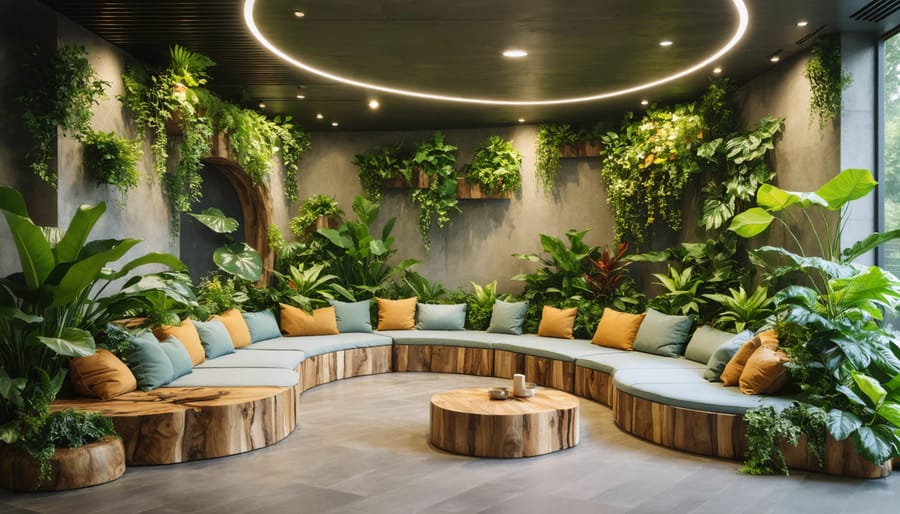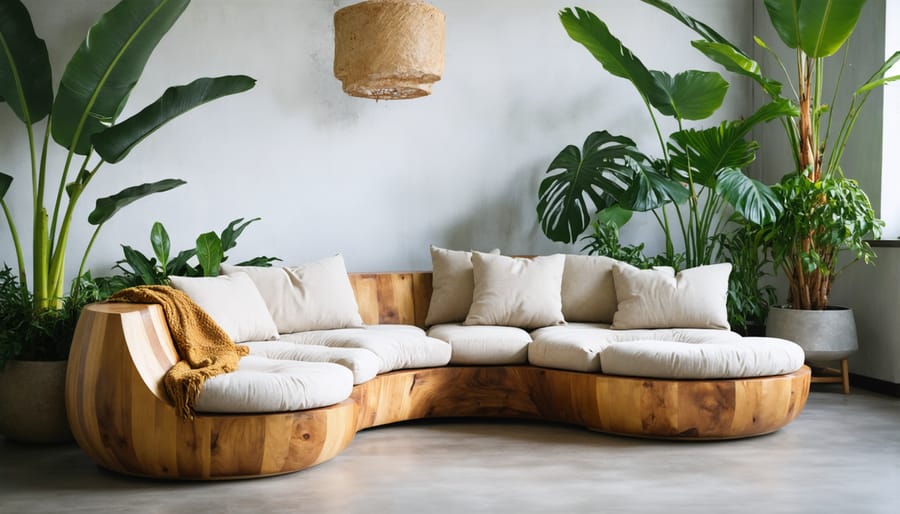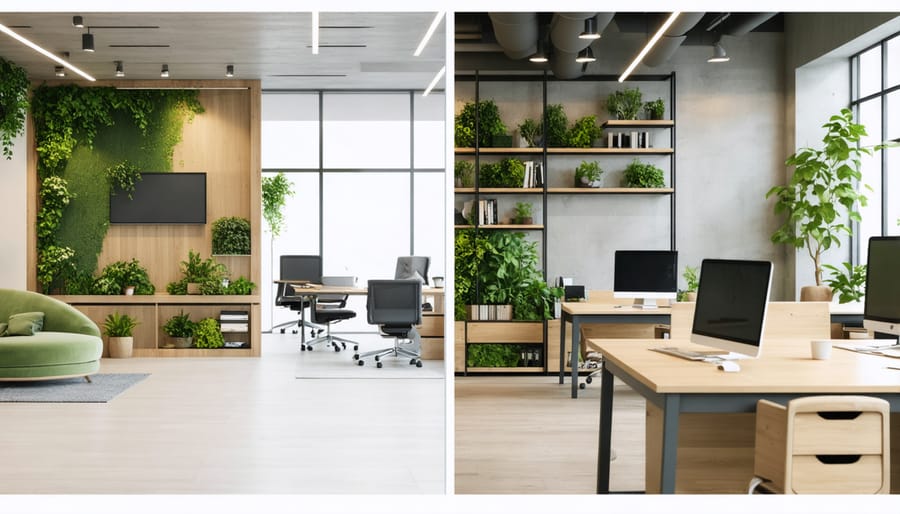
Transform your living and working spaces into vibrant, nature-connected environments with biophilic design furniture – where organic forms, natural materials, and living elements merge seamlessly with modern functionality. This revolutionary approach to interior design goes beyond mere aesthetics, tapping into our innate connection with nature to create spaces that enhance well-being, productivity, and emotional comfort.
Biophilic furniture represents a perfect fusion of nature-inspired design and practical utility, incorporating elements like living moss walls, reclaimed wood surfaces, and ergonomic shapes that mirror natural patterns. Research shows that spaces featuring biophilic design elements can reduce stress by 15%, enhance creativity by 15%, and improve overall well-being by creating a stronger connection to the natural world.
Whether you’re redesigning a corporate office to boost employee satisfaction or transforming your home into a natural sanctuary, biophilic furniture offers a sustainable, scientifically-backed solution that bridges the gap between indoor environments and nature. From modular green wall systems to organically curved seating solutions, these pieces don’t just furnish a space – they create an ecosystem that nurtures both body and mind.
The foundation of biophilic furniture design lies in its thoughtful incorporation of sustainable materials and lasting beauty. Natural wood, bamboo, cork, and stone form the cornerstone materials, each bringing unique characteristics that enhance both aesthetics and functionality. These materials create an immediate connection to nature through their authentic textures and organic patterns.
Raw wood surfaces, with their distinctive grain patterns and warm touch, offer a tactile experience that synthetic materials simply cannot match. Bamboo provides sustainability while delivering a sleek, modern appearance that appeals to eco-conscious consumers. Cork furniture pieces introduce interesting textural elements while providing natural acoustic properties and comfort.
The impact of these natural materials extends beyond visual appeal. Studies show that exposure to natural textures reduces stress levels and improves overall wellbeing. When selecting biophilic furniture, look for pieces that showcase the material’s natural characteristics – knots in wood, variations in stone patterns, or the subtle textures of woven natural fibers. These elements create a multi-sensory experience that strengthens our connection to nature while providing durable, functional pieces for everyday use.
Organic forms and patterns in biophilic furniture draw direct inspiration from nature’s geometry, creating pieces that seamlessly blend with our innate connection to the natural world. Popular design elements include curved lines that mimic flowing water, spiral patterns reminiscent of nautilus shells, and irregular edges that reflect natural wood growth patterns.
Many contemporary furniture designers incorporate these organic elements through undulating table edges, branch-like chair backs, and leaf-inspired cabinet handles. The use of fractal patterns – naturally repeating designs found in ferns, tree canopies, and river deltas – is particularly effective in creating visually engaging pieces that maintain a sense of order while celebrating nature’s complexity.
These nature-inspired shapes aren’t just aesthetically pleasing; they’re proven to reduce stress and enhance cognitive function in both home and office environments. Consider pieces like live-edge dining tables, which preserve the natural contours of the tree, or modular seating arrangements that mirror the cellular structures found in honeycomb patterns.
When selecting biophilic furniture, look for pieces that incorporate these organic forms while maintaining functionality. The key is finding the balance between natural aesthetics and practical use, ensuring the furniture serves its intended purpose while contributing to a more nurturing environment.

Research has consistently shown that incorporating natural elements into our living and working spaces through biophilic furniture design can significantly impact our psychological well-being. Studies conducted by environmental psychologists demonstrate that the emotional impact of furniture design with nature-inspired elements can reduce stress levels by up to 15% and increase overall satisfaction with indoor environments.
The presence of wooden furniture, for instance, has been linked to lower cortisol levels and decreased anxiety in both residential and commercial settings. Natural materials and organic shapes in furniture pieces trigger our innate connection to nature, promoting a sense of calm and reducing mental fatigue. Research from the University of Oregon found that employees working in spaces with biophilic furniture reported 15% higher levels of creativity and showed improved problem-solving abilities.
Moreover, furniture incorporating living elements like plant integrations or featuring nature-inspired patterns has been shown to enhance cognitive function and improve mood. The textural variety and organic forms characteristic of biophilic furniture stimulate our senses in ways that conventional furniture cannot, creating a more engaging and psychologically nurturing environment.
These benefits extend beyond individual well-being to impact group dynamics positively. In commercial settings, biophilic furniture installations have been associated with better team collaboration, reduced workplace stress, and increased employee retention rates. The psychological advantages make biophilic furniture design not just an aesthetic choice, but a strategic investment in mental health and productivity.

Biophilic design furniture goes beyond mere visual appeal by prioritizing ergonomic principles that support natural human movement and comfort. The incorporation of organic shapes and curves in seating mimics natural formations, allowing the body to settle into positions that feel instinctively right. For example, chairs with gentle contours inspired by river-worn stones provide superior lumbar support while maintaining aesthetic harmony with nature-inspired design elements.
Natural materials like sustainably sourced wood and bamboo offer thermal comfort advantages over synthetic alternatives. These materials naturally regulate temperature and humidity, creating more comfortable seating experiences throughout changing seasons. Additionally, textured surfaces and varied tactile experiences, common in biophilic furniture, encourage active engagement with our surroundings and promote better posture through increased body awareness.
Many biophilic furniture pieces feature adjustable elements that accommodate different body types and preferences. Height-adjustable desks with live-edge tops combine natural aesthetics with practical functionality, while modular seating arrangements inspired by organic patterns allow for flexible configurations that support both individual and collaborative activities.
The integration of natural elements like moss walls or living plant features within furniture pieces can also improve air quality and acoustic comfort, creating a more pleasant and productive environment. This multisensory approach to furniture design ensures that physical comfort works in harmony with psychological well-being, delivering a truly holistic user experience.
Each room in your home presents unique opportunities to transform your living space through biophilic design furniture. In living rooms, consider incorporating wood coffee tables with live edges or sofas upholstered in nature-inspired patterns and textures. Adding rattan accent chairs or bamboo side tables can create an immediate connection to natural elements.
For bedrooms, opt for organic bed frames crafted from reclaimed wood or sustainable materials. Nightstands featuring natural grain patterns and botanical-inspired drawer pulls can enhance the room’s connection to nature. Consider headboards made from woven natural fibers or featuring living plant installations.
Kitchen and dining areas benefit from solid wood tables with organic shapes, complemented by chairs incorporating natural materials like hemp or jute. Open shelving made from sustainable bamboo or reclaimed wood can display both functional items and natural decorative elements.
In home offices, focus on ergonomic chairs with natural fabric upholstery and desks featuring raw wood edges. Include storage solutions made from renewable materials like cork or bamboo to maintain organization while supporting environmental consciousness.
For outdoor living spaces, choose weather-resistant furniture that mirrors natural forms, such as curved benches that follow organic lines or tables with stone or wood-like surfaces. Create seamless indoor-outdoor transitions with consistent material choices and nature-inspired designs.
Commercial spaces can incorporate biophilic elements through modular furniture systems featuring living walls, planters integrated into seating areas, and room dividers made from sustainable materials that echo natural patterns and textures.
Natural materials in biophilic furniture require specific care to maintain their beauty and longevity. For wooden elements, regular dusting with a soft, microfiber cloth prevents buildup and protects the surface. Apply natural wood oil or beeswax polish every 3-6 months to nourish the wood and maintain its protective finish.
Living elements, such as moss walls or integrated planters, need consistent moisture monitoring. Use a humidity meter to ensure optimal conditions, and mist living walls according to the specific plant species requirements. For preserved moss installations, gentle dusting with compressed air maintains their vibrant appearance without causing damage.
Stone and concrete surfaces should be sealed annually to prevent staining and moisture damage. Clean these surfaces with pH-neutral cleaners to avoid deteriorating the sealant. For rattan and woven natural fibers, vacuum regularly using a soft brush attachment and avoid exposure to direct sunlight, which can cause fading and brittleness.
Leather elements require conditioning every 6-12 months to prevent cracking and maintain suppleness. Use natural leather cleaners and avoid harsh chemical products that can strip the material’s natural oils. For fabric upholstery incorporating natural fibers, prompt spot cleaning and regular professional cleaning help maintain appearance and extend lifespan.
Metal components, particularly those with living finish patinas, should be cleaned with a dry cloth only. Avoid chemical cleaners that might affect the natural aging process. For outdoor biophilic furniture, consider using protective covers during harsh weather conditions and bring portable pieces indoors during extreme weather events.
Regular maintenance inspections every three months help identify potential issues before they become significant problems, ensuring your biophilic furniture remains both beautiful and functional for years to come.

The sustainable production of biophilic furniture emphasizes eco-conscious materials and manufacturing processes that minimize environmental impact while maximizing natural elements. Leading manufacturers prioritize reclaimed wood furniture and responsibly sourced materials, ensuring each piece tells a story of environmental stewardship.
Natural materials like bamboo, cork, and certified sustainable hardwoods form the foundation of eco-friendly biophilic furniture. These renewable resources are complemented by recycled metals, bio-based plastics, and non-toxic finishes that maintain indoor air quality while reducing chemical exposure.
Modern production techniques emphasize zero-waste manufacturing, with companies implementing closed-loop systems that reuse and recycle materials throughout the production process. Water-based adhesives and low-VOC finishes have replaced traditional toxic alternatives, creating healthier furniture pieces that maintain their connection to nature.
Local sourcing plays a crucial role in reducing transportation emissions and supporting regional economies. Many manufacturers partner with nearby suppliers and artisans, ensuring transparency in their supply chain while maintaining high environmental standards.
Energy-efficient manufacturing facilities, often powered by renewable sources, demonstrate the industry’s commitment to reducing carbon footprints. Some producers even incorporate living walls and natural lighting in their facilities, embodying the biophilic principles in their production spaces as well as their products.
Biophilic design furniture often incorporates natural materials that can develop a beautiful patina over time, enhancing their character and connection to nature. Quality pieces typically have a lifespan of 15-20 years or more when properly maintained. Regular care, including dusting with natural cleaners and protecting from direct sunlight, helps preserve both the aesthetic and functional aspects of these pieces.
Natural materials like solid wood, bamboo, and rattan can be restored multiple times throughout their lifecycle, making them sustainable choices for long-term use. Professional restoration services can address wear patterns, sun damage, or structural issues, often extending the furniture’s life by several years. Many manufacturers now offer modular designs that allow for individual component replacement rather than complete furniture replacement.
The restoration process for biophilic furniture often involves eco-friendly techniques and materials, maintaining the piece’s natural properties while reducing environmental impact. Common restoration procedures include refinishing wooden surfaces, reweaving natural fiber elements, and updating sustainable upholstery materials. Some manufacturers provide lifetime warranties and restoration services, demonstrating their commitment to product longevity.
To maximize furniture lifespan, consider rotating pieces periodically to ensure even wear, maintaining proper humidity levels, and addressing any damage promptly. This proactive approach not only preserves the furniture’s biophilic qualities but also represents a sound investment in sustainable living spaces.
Biophilic design furniture represents more than just a passing trend – it’s a fundamental shift in how we approach interior spaces, seamlessly blending nature with functionality. By incorporating these elements into our homes and workplaces, we create environments that nurture well-being, boost productivity, and foster a deeper connection with the natural world.
As we’ve explored throughout this article, the benefits of biophilic furniture are numerous and well-documented. From reduced stress levels and improved air quality to enhanced creativity and increased property value, the investment in nature-inspired pieces pays dividends in both personal wellness and practical returns.
Remember that implementing biophilic design doesn’t require a complete overhaul of your space. Start small with a few key pieces – perhaps a living edge table, plant-integrated shelving, or furniture made from sustainable natural materials. Focus on elements that resonate with your existing décor while introducing organic shapes, textures, and materials.
The key to success lies in thoughtful selection and placement. Choose pieces that serve both form and function, ensuring they meet your practical needs while delivering the restorative benefits of natural elements. Whether you’re furnishing a home office, living room, or commercial space, the principles of biophilic design can be adapted to suit any environment.
Take the first step toward creating a more harmonious, nature-connected space today. Your well-being – and that of your family, employees, or customers – will thank you for it.